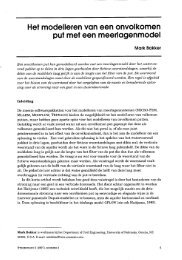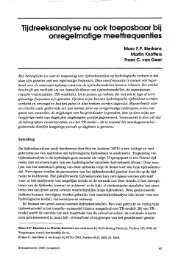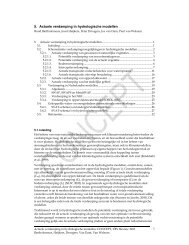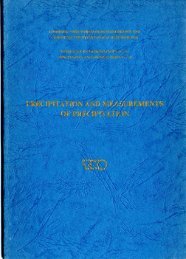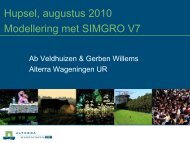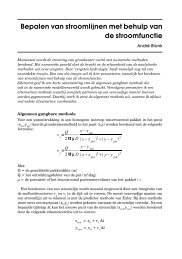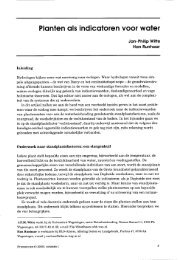Hydro-ecological relations in the Delta Waters
Hydro-ecological relations in the Delta Waters
Hydro-ecological relations in the Delta Waters
You also want an ePaper? Increase the reach of your titles
YUMPU automatically turns print PDFs into web optimized ePapers that Google loves.
fn tidal water systems sedimentation and erosian of sediment cont<strong>in</strong>ue<br />
above mean low waterlevel (KLW) and even mean high waterlevel (HXW).<br />
The lowest parts of <strong>the</strong> tidal zone have no vegetation except algae and<br />
some water plants (Zostera spec.). These tidal flats are m important<br />
feed<strong>in</strong>g habitat for birds (Meire, et al. 1989). Some decimetres below<br />
MEW <strong>the</strong> ffrst smi-terrestrial vegetation starts to grow (Salicornia<br />
spec., Spart<strong>in</strong>a spec.). This vegetation is usually <strong>in</strong>undated Cwice k<br />
day. %?hen accretion cont<strong>in</strong>tles to above MEW, vegetation develops to a<br />
variecy of plant communities. Geomarphology and vegeration of <strong>the</strong>se<br />
higher salt marshes are much more difgerentiated than on <strong>the</strong> mud flats<br />
and <strong>the</strong> lower salt marshes.<br />
The above-mentioned pattern of succession (see also Fig. 1) represents<br />
<strong>the</strong> situation it! <strong>the</strong> sd<strong>in</strong>e tidal are= of <strong>the</strong> South-West Ne<strong>the</strong>rlands.<br />
In <strong>the</strong> fresh and brackish tidal water systems this pattern is not<br />
essentially different, but <strong>the</strong>re is a difference <strong>in</strong> vegetation types of<br />
<strong>the</strong> marshes (reed, rushes and willars).<br />
The constru~tian of <strong>the</strong> <strong>Delta</strong> Works reaulted ia an ewrmous chanse of<br />
<strong>the</strong> estnariae environment. In most areas a more or less fixed<br />
wacerlevel w s realized somewhat aound NAP (butcb Ordnanoe Level). The<br />
consequence was that <strong>the</strong> lmr parts of <strong>the</strong> tidal land were pennwently<br />
<strong>in</strong>undated, while <strong>the</strong> higher parts were hardly iufluenced by <strong>the</strong><br />
flood<strong>in</strong>g water. Large parts of <strong>the</strong> latter could develop as (semi-)<br />
natural ecosystms. Thfs development and ite future perspectives for<br />
nature conservatLon are <strong>the</strong> subjects of this paper.<br />
2 ECOLllGICBI. DYNdMtCS I N VARIOUS WATERS<br />
The processes <strong>in</strong>fluenc<strong>in</strong>g <strong>the</strong> development of animal and plant<br />
communities cm be ordered <strong>in</strong> an hierarchical model (Fig. 2, derived<br />
from Bakker, et al. 1981). In this model <strong>the</strong> outer compartments<br />
dom<strong>in</strong>ate <strong>the</strong> <strong>in</strong>ner ones. Though <strong>the</strong>re is some <strong>in</strong>fluence <strong>in</strong> <strong>the</strong> opposite<br />
direction, this is of m<strong>in</strong>or importance becsuse of its lower





